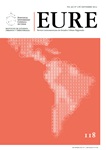The use of census zones to measure residential segregation. Contraindications, methodological proposal and a case study: Argentina 1991-2001
DOI:
https://doi.org/10.4067/S0250-71612013000300005Keywords:
segregation, urban sociology, information and communication technologiesAbstract
Attempts on measuring residential segregation using arbitrary spatial units constructed by census agencies carry certain drawbacks related to what is commonly known as the Modifiable Areal Unit Problem (MAUP). This problem has been generally ignored by urban researchers in this topic as if it would not affect the results of their studies. This paper discusses the legitimacy of using census zoning systems for measuring residential segregation, and proposes the use of data disaggregation and regrouping (DDR) techniques that may at some degree contribute in reducing MAUP biases. One of these techniques is used for measuring socioeconomic residential segregation trends in Argentina for the 1991-2001 period. We conclude that in countries like Argentina these techniques represent just a partial and limited solution to MAUP. Quality and precision of quantitative studies on residential segregation and other fields dealing with similar problems may be substantially improved only if better access to spatially disaggregated data is provided by census agencies.
ÍDownloads
Published
How to Cite
Issue
Section
License
Copyright (c) 2013 Revista EURE - Revista de Estudios Urbano Regionales

This work is licensed under a Creative Commons Attribution 4.0 International License.
Al momento de aceptar la publicación de sus artículos, los autores deberán formalizar la cesión de derechos de autor a EURE, según las condiciones establecidas por la Revista.
Ésta establece que el autor autoriza a EURE de manera gratuita, exclusiva e ilimitada a reproducir, editar, publicar, distribuir, publicitar, comercializar y traducir el artículo, a cualquier soporte conocido o por conocer y desarrollar.
Del mismo modo, los autores aseguran que el artículo propuesto es original, no publicado y no propuesto para tal fin a otro medio de difusión.


